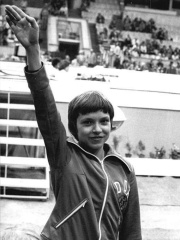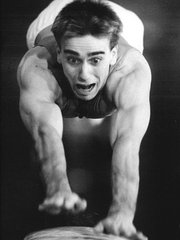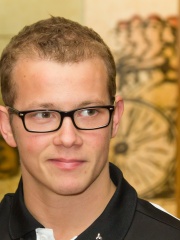







The Most Famous
GYMNASTS from Germany
Top 10
The following people are considered by Pantheon to be the top 10 most legendary German Gymnasts of all time. This list of famous German Gymnasts is sorted by HPI (Historical Popularity Index), a metric that aggregates information on a biography's online popularity. Visit the rankings page to view the entire list of German Gymnasts.

1. Carl Schuhmann (1869 - 1946)
With an HPI of 66.29, Carl Schuhmann is the most famous German Gymnast. His biography has been translated into 37 different languages on wikipedia.
Carl August Berthold Schuhmann (12 May 1869 – 24 March 1946) was a German athlete who won four Olympic titles in gymnastics and wrestling at the 1896 Summer Olympics in Athens, becoming the most successful athlete at the inaugural Olympics of the modern era. He also competed in weightlifting.

2. Hermann Weingärtner (1864 - 1919)
With an HPI of 65.66, Hermann Weingärtner is the 2nd most famous German Gymnast. His biography has been translated into 31 different languages.
Otto Ludwig Hermann Weingärtner (27 August 1864 – 22 December 1919) was a German gymnast. He started his career in his hometown Frankfurt (Oder) at the local gymnastics club Frankfurter Turnverein 1860. Later on he moved to Berlin to compete for the Deutsche Turnerschaft. He competed at the 1896 Summer Olympics in Athens. Weingärtner was a member of the German team that won two gold medals by placing first in both of the team events, the parallel bars and the horizontal bar. He also won a number of individual medals, taking the gold in the horizontal bar, silver in pommel horse and rings, and bronze in the vault. He competed in the parallel bars, but did not win a medal in that event. His six medals arguably made him the most successful competitor at the first modern Olympic Games. After his return to Germany he and most of the other German gymnasts were suspended because the Deutsche Turnerschaft (at this time the governing body of German gymnastics) boycotted the Olympic games with the reason that competing is "un-German". So he moved back to Frankfurt (Oder) to manage the open-air swimming pool founded by his father on the Ziegenwerder island. He drowned trying to rescue a person from drowning in the Oder. In 1996, the main footpath on the Ziegenwerder island was named Hermann-Weingärtner-Weg.

3. Conrad Böcker (1870 - 1936)
With an HPI of 62.54, Conrad Böcker is the 3rd most famous German Gymnast. His biography has been translated into 25 different languages.
Conrad Helmut Fritz Böcker (24 August 1870 in Leipzig – 8 April 1936 in Frankfurt) was a German gymnast. He competed at the 1896 Summer Olympics in Athens. Böcker had little success in individual events. He competed in the parallel bars, horizontal bar, vault, pommel horse, and rings events. In none of them was he among the medallists. He did, however, win two gold medals as part of the German team in the two team events, on parallel bars and the horizontal bar.

4. Alfred Schwarzmann (1912 - 2000)
With an HPI of 60.11, Alfred Schwarzmann is the 4th most famous German Gymnast. His biography has been translated into 23 different languages.
Alfred Schwarzmann (22 March 1912 – 11 March 2000) was a German Olympic gymnast. He won three gold and two bronze medals at the 1936 Berlin Olympics and another silver medal at the 1952 Summer Olympics. During World War II, Schwarzmann served in the Wehrmacht and was a recipient of the Knight's Cross of the Iron Cross of Nazi Germany.

5. Konrad Frey (1909 - 1974)
With an HPI of 56.17, Konrad Frey is the 5th most famous German Gymnast. His biography has been translated into 18 different languages.
Konrad Frey (24 April 1909 in Bad Kreuznach – 24 May 1974 ib.) was a German gymnast best known to be the most successful German male competitor at a single Olympics. With 3 Gold and 6 medals in total at the 1936 Summer Olympics, he had beaten team-mate Alfred Schwarzmann by one Silver for the honours of becoming the most successful competitor in term of total medals won, and the most successful competitor of host nation Germany. American Jesse Owens scored four medals, but all of them Gold. In 1932, 1935 and 1937, Konrad Frey became German Champion in Men's individual all-round. After World War II, he worked again as teacher.

6. Klaus Köste (1943 - 2012)
With an HPI of 55.69, Klaus Köste is the 6th most famous German Gymnast. His biography has been translated into 17 different languages.
Klaus Köste (27 February 1943 – 14 December 2012) was a German gymnast. He won a gold medal in the vault at the 1972 Summer Olympics in Munich. He competed for East Germany and won bronze medals in the team all-around event in three Olympics, in 1964, 1968 and 1972. He was particularly strong on the horizontal bar, winning the 1971 and 1973 European championships and a bronze medal at the 1970 World championship in this event. Köste started training in gymnastics at the age of six in Frankfurt (Oder), but later moved to Leipzig where he lived for the rest of his life. During his career he won 34 national titles, becoming one of the most successful German gymnast, together with Eberhard Gienger. In 1972 he was awarded the Patriotic Order of Merit. He retired from competitions in 1974 due to an Achilles tendon injury and became a trainer and high school teacher. In 1974–1976 he was the head coach of the East German women’s team and between 1976 and 1985 worked as the chief trainer of SC Leipzig. In parallel he taught sports at DHfK Leipzig. During the period of 1998–2002 he was an assistant to Gustav-Adolf Schur who was when a member of the Bundestag. He died from a heart failure in 2012.

7. Roland Brückner (b. 1955)
With an HPI of 51.59, Roland Brückner is the 7th most famous German Gymnast. His biography has been translated into 18 different languages.
Roland Brückner (born 14 December 1955) is a retired East German gymnast. He competed at the 1976 and 1980 Summer Olympics in all artistic gymnastics events and won a bronze and a silver medal in the team competition, respectively. Individually he won a gold in the floor exercise and two bronze medals in the vault and parallel bars in 1980. He won two more gold medals in the floor exercise at the 1979 World Artistic Gymnastics Championships and 1981 European championships. He missed the 1984 Summer Olympics due to their boycott by East Germany and competed at the Friendship Games instead, winning a gold on the floor and a silver in the team competition. He retired from competitions shortly after the 1984 Friendship Games and later worked as a trainer, near Ulm in Germany and at the NKL Liestal, Switzerland. He was chosen the 1984 Gymnast of the Year in East Germany. He is married and has two children, Sandra and Thomas.

8. George Eyser (1870 - 1919)
With an HPI of 51.54, George Eyser is the 8th most famous German Gymnast. His biography has been translated into 20 different languages.
George Louis Eyser (August 31, 1870 – March 6, 1919) was a German-American gymnast who competed in the 1904 Summer Olympics, earning six medals in one day, including three gold and two silver medals. Eyser competed with a wooden prosthesis for a left leg, having lost his leg after being run over by a train. Despite his disability, he won gold in the vault, an event which then included a jump over a long horse without aid of a springboard.

9. Maxi Gnauck (b. 1964)
With an HPI of 50.91, Maxi Gnauck is the 9th most famous German Gymnast. Her biography has been translated into 23 different languages.
Maxi Gnauck (born 10 October 1964) is a German former artistic gymnast who represented East Germany. With a total of 27 medals at the Olympic Games, World Championships, World Cups, and European Championships she is considered one of the most successful woman gymnasts that Germany has ever produced. In 1980 she was selected East German Sportspersonality of the Year. Her parents were expecting a boy and they planned to name him Max so, when the baby turned out to be a girl, they simply added an 'i', creating an uncommon name for Germany. When Maxi was five, her mother took her to a gymnastics centre in their area. By age eight, Maxi had won her first medals at the Kreisspartakiade. When she was nine she changed her club to SC Dynamo Berlin, where she was coached by Jürgen Heritz. Considered one of the best uneven bars competitors of all time, Maxi was also an excellent tumbler. She was one of the first female gymnasts to perform a triple twist on floor. In April 1986, Maxi officially announced her retirement and began a four-year course in sports coaching at the University of Leipzig. In 1988 she was severely injured while sliding down a waterslide while working as an aide at a children's summer camp by the Baltic Sea. She broke her C5 vertebra and was nearly paralysed. Three vertebrae were later reinforced with a metal plate. Facing a strong competition after the reunification of East Germany and West Germany, she first took temporary coaching positions in South Africa and Great Britain, both for a few months in 1990. From 1993 until 2004 she worked as a full-time coach at the Harksheide Gymnastics Center in Norderstedt near Hamburg. Since 2005 she has worked at the Artistic and Apparatus Gymnastics Center (Kunst- und Gerätturnzentrum) at Liestal in Switzerland. In 2000, she was inducted into the International Gymnastics Hall of Fame. She is the first German gymnast to be awarded that honour.

10. Sylvio Kroll (b. 1965)
With an HPI of 45.68, Sylvio Kroll is the 10th most famous German Gymnast. His biography has been translated into 15 different languages.
Sylvio Kroll (born 29 April 1965 in Lübben) is a German former gymnast who competed in the 1988 Summer Olympics and in the 1992 Summer Olympics. In October 1986, he was awarded a Star of People's Friendship in gold (second class) for his sporting success.
People
Pantheon has 22 people classified as German gymnasts born between 1864 and 1999. Of these 22, 15 (68.18%) of them are still alive today. The most famous living German gymnasts include Roland Brückner, Maxi Gnauck, and Sylvio Kroll. The most famous deceased German gymnasts include Carl Schuhmann, Hermann Weingärtner, and Conrad Böcker. As of April 2024, 4 new German gymnasts have been added to Pantheon including Sylvio Kroll, Holger Behrendt, and Dagmar Kersten.
Living German Gymnasts
Go to all RankingsRoland Brückner
1955 - Present
HPI: 51.59
Maxi Gnauck
1964 - Present
HPI: 50.91
Sylvio Kroll
1965 - Present
HPI: 45.68
Holger Behrendt
1964 - Present
HPI: 45.31
Andreas Wecker
1970 - Present
HPI: 44.55
Marcel Nguyen
1987 - Present
HPI: 44.38
Fabian Hambüchen
1987 - Present
HPI: 42.97
Dagmar Kersten
1970 - Present
HPI: 41.92
Isao Yoneda
1977 - Present
HPI: 37.27
Philipp Boy
1987 - Present
HPI: 35.99
Elisabeth Seitz
1993 - Present
HPI: 33.72
Lukas Dauser
1993 - Present
HPI: 32.53
Deceased German Gymnasts
Go to all RankingsCarl Schuhmann
1869 - 1946
HPI: 66.29
Hermann Weingärtner
1864 - 1919
HPI: 65.66
Conrad Böcker
1870 - 1936
HPI: 62.54
Alfred Schwarzmann
1912 - 2000
HPI: 60.11
Konrad Frey
1909 - 1974
HPI: 56.17
Klaus Köste
1943 - 2012
HPI: 55.69
George Eyser
1870 - 1919
HPI: 51.54
Newly Added German Gymnasts (2025)
Go to all RankingsSylvio Kroll
1965 - Present
HPI: 45.68
Holger Behrendt
1964 - Present
HPI: 45.31
Dagmar Kersten
1970 - Present
HPI: 41.92
Isao Yoneda
1977 - Present
HPI: 37.27
Overlapping Lives
Which Gymnasts were alive at the same time? This visualization shows the lifespans of the 6 most globally memorable Gymnasts since 1700.










